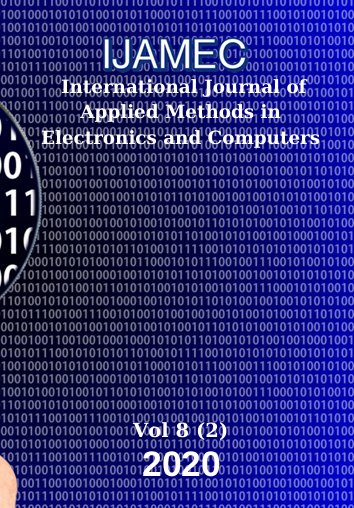Detection of Breast Region of Interest via Breast MR Scan on an Axial Slice
DOI:
https://doi.org/10.18100/ijamec.679142Keywords:
Breast cancer, Region of interest, Magnetic resonance imaging, Local adaptive thresholding, Connected component analysisAbstract
Breast cancer is one of the most common cancer types especially met in women. The number of breast cancer patients increases every year. Thus, to detect breast cancer at its early stages gains importance. Breast region detection is the pioneering step of breast cancer diagnosis researches performed via image processing techniques. The performance of computer-aided breast cancer diagnosis systems can be improved by exactly determining the breast region of interest. In this study, the goal is to determine a region of interest for breast MR images, in which one or more lesion can appear. The achieved region includes two breasts and lymph nodes. The proposed region of interest detection system is fully automatic and it utilizes several image processing techniques. At first, the local adaptive thresholding technique is applied to the noise-filtered grey level breast magnetic resonance images taken with ethical permissions from Sakarya Education and Research Hospital. After adaptive thresholding, connected component analysis is performed to exclude extra structures around the breast region as thorax area. This analysis selects the largest area in the binary image which corresponds to a gyrate region including breast area and lymph nodes over the backbone. Then, the integral of horizontal projection is calculated to determine an optimum horizontal line that allows setting the region of interest apart. In the following step, sternum midpoint is detected to separate the right breast from the left one. Finally, a masking operation is applied to get corresponding right and left breast regions in the original MR image. To evaluate the performance of the proposed study, the results of automatic region of interest detection system are compared with the manual region of interest selection performed by an expert radiologist. Dice similarity coefficient and Jaccard coefficient are used as performance criteria. According to the results, the proposed system can detect region of interest for computer-aided breast cancer diagnosis researches, exactly.Downloads
References
https://www.who.int/cancer/prevention/diagnosis-screening/breast-cancer/en/. World Health Organization (2019) Accessed 12 December 2019.
T.C. Sağlık Bakanlığı Türkiye Halk Sağlığı Kurumu, Türkiye Kanser İstatistikleri, Ankara, 2017.
G. Çetinel and S. Gül, “Breast Lesion Segmentation and Area Calculation for MR Images,” Int. J. Image, Graph. Signal Process., vol. 10, no. 10, pp. 1–10, 2018.
S. Renukalatha and K. V Suresh, “Automatic Roi Extraction in Noisy Medical Images,” ICTACT J. Image Video Process., vol. 7, no. 4, pp. 1505–1514, 2018.
A. Fooladivanda, S. B. Shokouhi, N. Ahmadinejad, and M. R. Mosavi, “Automatic segmentation of breast and fibroglandular tissue in breast MRI using local adaptive thresholding,” 2014 21st Iran. Conf. Biomed. Eng. ICBME 2014, no. Icbme, pp. 195–200, 2014.
G. Piantadosi, S. Marrone, R. Fusco, M. Sansone, and C. Sansone, “Comprehensive computer-aided diagnosis for breast T1-weighted DCE-MRI through quantitative dynamical features and spatio-temporal local binary patterns,” IET Comput. Vis., vol. 12, no. 7, pp. 1007–1017, 2018.
D. Pandey, X. Yin, H. Wang, M. Y. Su, J. H. Chen, J. Wu, and Y. Zhang, “Automatic and fast segmentation of breast region-of-interest (ROI) and density in MRIs”, Elsevier Heliyon, vol. 4, 2018.
T. Kettunan et al., “ Peritumoral ADC values in breast cancer: region of interest selection, association with hyaluronan intensity, and prognostic significance”, European Radiology, vol. 30, pp. 38-46, 2020.
D. Wei et al., “Three dimensional whole breast segmentation in saggital and axial breast MRI with dense depth field modeling and localized self-adaptation for chest-wall line detection”, IEEE Trans. on Biomedical Eng., vol. 66, pp. 1567-1579, 2019.
Marrone S, Piantadosi G, Fusco R, Petrillo A, Sansone M, Sansone C (2016) Breast segmentation using Fuzzy C-Means and anatomical priors in DCE-MRI. Proc. Int. Conf. Pattern Recognition 1472–1477 https://doi.org/ 1010.1109/ICPR.2016.7899845.
Commons C, License A (2015) Automatic Segmentation in Breast Cancer Using Watershed Algorithm. International Journal of Biomedical Engineering and Science (IJBES), 2: 1-6.
Moftah HM, Azar AT, Al-Sahammari ET (2013) Adaptive k-means clustering algorithm for MR breast image segmentation. Neural Computing and Appl. 24:7-8 https://doi.org/10.1007/s00521-013-1437-4.
Ertaş G, Gülçür HÖ, Osman O, Uçan ON, Tunaci M, Dursun M (2008) Breast MR segmentation and lesion detection with cellular neural networks and 3D template matching. Comput. Biol. Med. 38: 116–126 https://doi.org/10.1016/j.compbiomed.2007.08.001
Glaßer S, Niemann U, Preim B, Spiliopoulou M (2013) Can we distinguish between benign and malignant breast tumors in DCE-MRI by studying a tumor’s most suspect region only? Proc. of 26th IEEE Int. Symp. Comput. Med. Syst.: 77-82.
P. Sharma et al., “ A new approach for image segmentation using improved k-means and ROI saliency map”, Journal of Information and Optimization Sciences , vol. 38, pp. 927-935, 2017.
T. R. Singh, S. Roy, O. I. Singh, T. Sinam, and K. M. Singh, “A New Local Adaptive Thresholding Technique in Binarization”, Computer Vision and Pattern Recognition, vol. 8, pp. 271-277, 2011.
F. Shafait, Keysers D, T. M. Breuel, “Efficient implementation of local adaptive thresholding techniques using integral images”, Proceedings of SPIE, CA, USA, January 29-31, 2008.
L. He, X. Ren, Q. Gao, X. Zhao, B. Yao, and Y. Chao, “The connected-component labeling problem: A review of state-of-the-art algorithms,” Pattern Recognit., vol. 70, pp. 25–43, 2017.
M. Kallenberg, B. Platel, R. M. Mann, R. Martí, A. Gubern-Mérida, and N. Karssemeijer, “Volumetric Breast Density Estimation from Full-Field Digital Mammograms: A Validation Study,” PLoS One, vol. 9, no. 1, p. e85952, 2014.
Downloads
Published
Issue
Section
License
Copyright (c) 2020 International Journal of Applied Methods in Electronics and Computers

This work is licensed under a Creative Commons Attribution-ShareAlike 4.0 International License.





